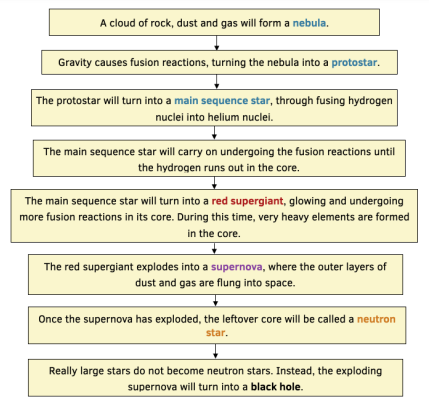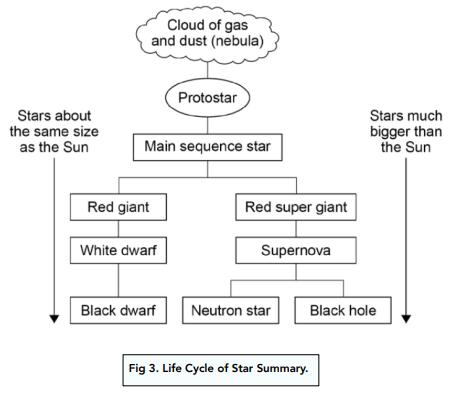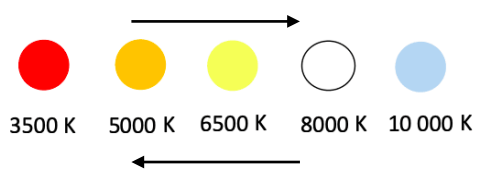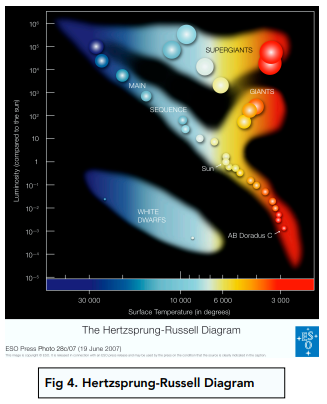Life Cycle of a Star (GCSE Physics)
Life Cycle of a Star
Star Size and Life Cycle
- Stars have a life cycle. All the stars in our Solar System go through a life cycle, including formation, stabilisation and eventual destruction.
- Stars are various sizes. In our Solar System, the stars are all different sizes. Some are the size of the Sun, some are smaller than the Sun, whilst others are bigger than the Sun. When you look at a star, whether it be via a telescope or just using your eyes, the size you see is determined by i) its actual size, and ii) the distance from you.
- The life cycle depends on star size. The life cycle of a star will depend on the size of the star. Small stars, like the Sun, will go through one particular life cycle, whilst larger stars will go through another life cycle.
Steps in the Life Cycles of Stars
Stars the Size of the Sun
The Sun is a relatively small star in our Milky Way. Its life cycle follows a particular path, as shown below:

Stars Bigger than the Sun
Stars bigger than the Sun will follow a different life cycle:


Summary of the Life Cycle
Here is a summary diagram showing the life cycle of stars.

Colour and Surface Temperature
We’ve seen that stars can be found and classified based on their colour. The colour of a star also reflects the surface temperature of a star. This is because very hot objects emit visible light, which is seen as different colours.

The more blue a star, the higher the temperature of a star.
The more red a star, the lower the temperature of a star.
Absolute Magnitude
Two factors can affect the brightness of a star:
- Emission of visible light
- Distance of the star
The absolute magnitude of stars determines the brightness of a star, without distance being a variable.
The brighter the star, the lower the magnitude.
The dimmer the star, the higher the magnitude.
Hertzsprung-Russell Diagrams
We’ve covered the temperature and absolute magnitude of a star. This information can be presented graphically on a Hertzsprung-Russell diagram.

As you can see, the temperature of the star is on the x axis and the absolute magnitude of the star is on the y axis.
Most of the stars on the graph can be found going from the top left of the graph to the bottom right. We called this the Main Sequence.
Other important features on Hertzsprung-Russell diagrams include the White Dwarfs, the Red Giants and the Red supergiants.
Forming New Elements
In this section we will learn about the many elements which are found in stars. We will learn how they are formed and distributed.
Formation of the Elements
The fusion reactions that occur in stars are used produce new elements. In the core of the star, we find hydrogen nuclei and many other light elements. At very high temperatures, the nuclei of these elements are used in nuclear fusion reactions.
As the nuclei of these light elements join together, they will form new, heavier elements. For example, when hydrogen nuclei join together, they form helium nuclei.
Distributing the Elements
Although elements are formed in the cores of stars, they can be distributed across the universe. This is occurs through a supernova, which we discussed in the previous section. The elements are distributed along with the layers of gas and dust that are flung into space.
Heavier Elements
In the previous section, we discussed that very heavy elements are produced in stars bigger than the Sun. These elements can be heavier than iron. These elements are the ones that will be distributed in supernovae throughout the universe.

A star is a large, glowing ball of gas in space that gives off light and heat. Stars are made up of hot, dense gas that is constantly undergoing nuclear reactions, which release a tremendous amount of energy in the form of light and heat.
The life cycle of a star begins with a cloud of gas and dust in space. This cloud collapses under its own gravity to form a protostar, which then continues to contract and heat up until it becomes a main sequence star. After it has used up most of its fuel, a star may expand into a red giant and then eventually collapse to form a white dwarf. In some cases, a star can also go supernova and become a neutron star or a black hole.
A protostar is a stage in the life cycle of a star, when a cloud of gas and dust has begun to contract under its own gravity but has not yet become hot enough to start shining. As the protostar continues to contract and heat up, it eventually becomes a main sequence star.
A main sequence star is the stage in the life cycle of a star when it is shining brightly and stable, and is producing energy through nuclear reactions in its core. Our Sun is a main sequence star, and this stage can last billions of years depending on the size of the star.
When a star runs out of fuel, it can no longer produce energy through nuclear reactions in its core. This can cause the star to expand into a red giant, or in some cases, it can go supernova.
A red giant is a stage in the life cycle of a star, when it has run out of fuel in its core and has expanded to many times its original size. Red giants are much cooler and less dense than main sequence stars, but they are still incredibly bright.
A white dwarf is the final stage in the life cycle of a star that is similar in size to the Sun. When a star has used up all of its fuel and can no longer produce energy, it collapses to form a white dwarf, which is a small, very dense star that is no longer producing light or heat.
A supernova is a tremendous explosion that occurs when a star has run out of fuel and can no longer produce energy. The explosion releases a tremendous amount of energy in the form of light, heat, and matter, and can sometimes leave behind a neutron star or a black hole.





Still got a question? Leave a comment
Leave a comment